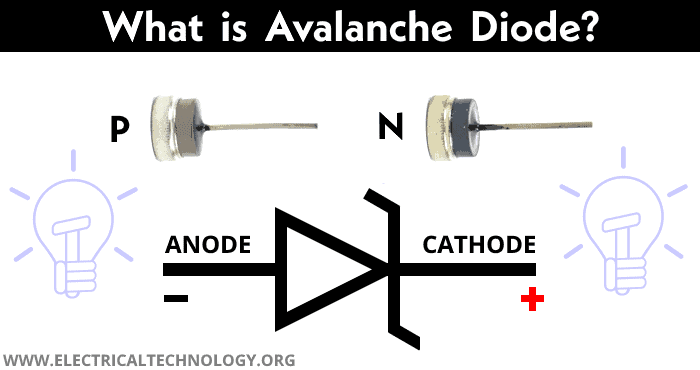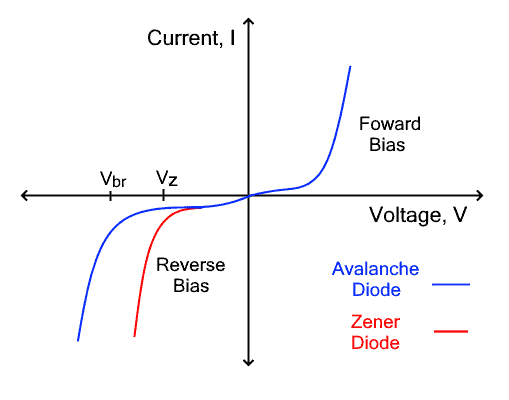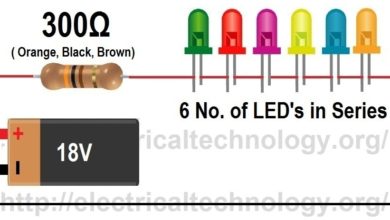What is Avalanche Diode? Construction, Working, Types & Applications
Avalanche Diode – Symbol, Construction, Working, Types and Applications
The diode is a semiconductor-based electronic switch that allows current in only one direction. It’s like a one-way valve that allows current in only one direction. It has two terminals named anode and cathode. It allows current when its anode is at a higher potential than its cathode. It is made of a semiconductor material such as silicon and germanium. Diodes are used in applications for switching, rectification, voltage regulation, etc.
Different types of diodes are designed for their specific functions. An Avalanche diode is one of the many types of diodes usually used for protection against high voltages.
What is Avalanche Diode?
The avalanche diode is a type of diode that is specifically designed to operate in reverse breakdown or avalanche breakdown region. They are designed to break at a precise voltage where the voltage level is determined by the doping concentration.
Conventional PN junction diode has a huge current concentration that creates hot spots causing irreversible damage. The junction of the avalanche diode is designed to prevent such current concentration and hot spots. Therefore the avalanche diode does not get damaged in the avalanche breakdown region.
It has a similar operation as the Zener diode, it conducts in both forward and reverses bias. But the avalanche diode provides far better voltage surge protection than the Zener diode.
Related Posts:
- What is Diode? Construction and Working of PN Junction Diode
- Types of Diodes and Their Applications – 24 Types of Diodes
Symbol of Avalanche Diode
The symbol of the avalanche diode is similar to the Zener diode. It has two terminals anode and a cathode. Its symbol is given below.
As you can see, its symbol is similar to a normal PN diode except for the bent edges of the bar.
Construction
Avalanche diode is made of a semiconductor material such as Silicon and Germanium. Semiconductors are naturally neutral i.e. the number of free electrons and holes are equal. Therefore Impurities are added to increase their amount and conductivity.
Pentavalent impurities are added to increase the number of electrons and form an N-Type semiconductor while trivalent impurities are added to increase the number of holes to form a P-Type semiconductor. The P-Type and N-Type are diffused together to form a PN junction. A metallic layer is deposited on both sides to form anode and cathode terminals.
The structure of the avalanche diode resembles that of the Zener diode. Both of them are made of semiconductor materials such as silicon and germanium except for their doping concentration.
The Zener diode has a very high doping concentration creating a thin depletion region. Therefore the reverse breakdown occurs at a very low reverse voltage in the Zener diode. Whereas the Zener diode has a lighter doping concentration as compared to the avalanche diode resulting in a wider depletion region.
Due to this wide depletion region, the breakdown in the avalanche diode occurs at very high voltages. The breakdown voltage depends on the doping concentration and it is maintained during its manufacture.
Another main difference between them is that the Zener diode has a positive temperature coefficient while the avalanche diode has a negative temperature coefficient. It provides better protection against voltage surges than the Zener diode
Related Posts:
- Schottky Diode: Construction, Working, Advantages and Applications
- Shockley Diode: Construction, Working, Characteristics and Applications
Working
An avalanche diode conducts in both forward and reverses bias, unlike a conventional PN diode. However, it is designed to operate in reverse bias in the avalanche breakdown region.
Forward Bias
In forward bias, the anode terminal is connected to the positive while the cathode terminal is connected to the negative terminal of the voltage source.
The depletion region shrinks due to the applied potential difference across it. Once the voltage exceeds the limit called forward voltage, the diode starts conduction as in a conventional PN diode.
Reverse Bias
In reverse bias, the anode is connected to the negative while the cathode is connected to the positive terminal of the battery or the voltage at the cathode is greater than on the anode. The Avalanche diode is designed to operate in reverse bias.
Due to the application of reverse voltage, the majority carriers that are electrons in the N-region and the majority carriers that are holes in the P-Type region pull away from the junction. This expands the depletion region increasing its width. Therefore there is no current flow due to majority carriers. However, there is a small amount of current flow between the junction due to the flow of minority carriers called the reverse leakage current.
With an increase in the reverse voltage, the minority carriers gain more energy attaining high speed. These minority carriers electrons moving at a very high speed collides with the atoms in the semiconductor material and transfer their energy to its valance electron releasing it from its atom generating electron-hole pair. The electrons further collide with other atoms generating more free electrons. This collision generates a large number of minority carriers.
The number of minority carriers increases with an increase in the reverse voltage. At a certain voltage, the minority carriers rip through the junction allowing a very large current in the reverse direction. This phenomenon is called avalanche breakdown and the voltage is called the breakdown voltage.
A conventional PN diode experiences irreversible damage while an avalanche diode does not get damaged in avalanche breakdown.
Related Posts:
- LED – Light Emitting Diode: Construction, Working, Types and Applications
- Photodiode: Types, Construction, Operation, Modes, Performance and Applications
Avalanche Breakdown and Zener Breakdown
Avalanche breakdown occurs at a larger reverse voltage due to the wider depletion region. Whereas the Zener breakdown occurs at a very lower voltage due to the thinner depletion region.
The avalanche breakdown occurs due to low doping concentration while the Zener occurs due to high doping concentration in the semiconductor material. The avalanche breakdown voltage decrease with the increase in temperature while Zener breakdown increase with an increase in temperature.
Avalanche Noise
Avalanche noise is a type of noise that is generated when a PN junction operates near the avalanche breakdown region. Such a form of noise does not occur anywhere else in a circuit except for in diodes. This property of the Avalanche diode can be used to generate noise for testing other devices. However, this noise must be removed using a filter.
V-I Characteristics of Avalanche Diode
The VI characteristic graph shows the relationship between the applied voltage and the current flowing through it. The x-axis represents the voltage while the Y-axis represents the current as shown in the figure below.
In forward bias, the avalanche diode acts as a normal PN diode and it conducts once the voltage exceeds the forward diode voltage.
In reverse bias, it shows a similar response as the Zener diode. The graph shows the comparison between the avalanche breakdown and Zener breakdown.
The avalanche diode does not conduct unless the voltage is lower than the reverse breakdown voltage. However, there is a small leakage current that remains constant. When the voltage exceeds the breakdown voltage, the reverse current exponentially increases.
The graph shows that the Zener breakdown occurs at a lower voltage than the avalanche breakdown.
Related Posts:
- Fast Recovery Diode? Symbol, Construction, Working and Applications
- Step Recovery Diode – SRD: Construction, Working and Applications
Advantages and Disadvantages of Avalanche Diodes
Advantages
Here are some advantages of Avalanche diode
- The Avalanche diode protects the circuit from high voltage and current surges.
- It has a relatively more precise breakdown voltage as compared to Zener.
- It has higher sensitivity.
- It has a fast response time.
- The reverse breakdown does not damage the diode, unlike the normal PN diode. Thus it can be reused.
- It requires a lower doping concentration as compared to Zener.
- It has better performance against surges
Disadvantages
Here are some disadvantages of avalanche diode
- It has a higher value of noise generation as compared to a normal PN diode.
- It requires a higher voltage than the Zener diode.
- It is not very reliable.
- The response is not linear.
Applications
Avalanche diode is mainly used for protection against surges. Here are some applications of avalanche diode.
- The Avalanche diode is connected in parallel with the circuit. When the voltage across the circuit starts to increase beyond the safe limit, the avalanche breakdown occurs and the avalanche diode starts conduction. Thus the diode diverts the large current from the circuit to prevent it from being damaged.
- It is also used as a white noise generator in circuits. It is used in radio gears to generate RF noise.
- It is used in application where frequent voltage spike occurs as the reverse breakdown does not damage it.
- It can withstand high current thus it is used in high-power devices.
Related Posts:
- Zener Diode – Symbol, Construction, Circuit, Working and Applications
- Backward Diode: Construction, Operation, Characteristics and Applications
- Laser Diode – Construction, Working, Types and Applications
- Tunnel Diode: Construction, Working, Advantages, and Applications
- Blocking Diode and Bypass Diodes in a Solar Panel Junction Box
- Difference Between Schottky Diode and Fast Recovery Diode
- Diode Formulas and Equations – Zenner, Shockley and Rectifier
- Diode Symbols – Electronic and Electrical Symbols
- Applications of Diodes









